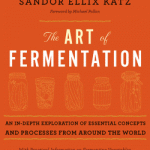Award Winning Author
Face Reading with Before & After Photos
The Art of Fermentation
If you are interested in the connection between health and diet, here’s some important news. Sandor Katz’s new book, The Art of Fermentation is the first definitive guide on fermented foods with recipes taken from around the world.
Today its rare for a cookbook to become adorned with the splatters and smudges that accumulate on real kitchen companion. And herein suggests Katz’ gift and genius. He demystifies fermenting foods and inspires—almost propels—you into the kitchen to start chopping or brewing. Sauerkraut, kefir, injera, mead and idli are but a few of the representative recipes.
Katz aptly observes that unlike cooks before our time, we grew up in the era during the War on Bacteria and so didn’t dare try fermenting foods ourselves. He not only makes the process doable and gives us multiple—and surprising—reasons as to why we should reclaim this venerable heritage. Indeed, he makes a compelling case that food preservation and cultural preservation are inextricably linked.
Fermentation is far more than a preservation method, it makes our food more digestible and delicious giving them “complex and edgy” flavors. Recipes are included for fermented vegetables, meats, eggs, dairy, and he also covers fermented beverages.
In his introduction Michael Pollan says that this “…is an inspiring book, and I mean that literally. The book has inspired me to do things I’ve never done before, and probably never would have done if I hadn’t read it. In fact Katz’s book is the main reason the my kitchen counters and basement floor have lately sprouted an assortment of mason jars, ceramic crocks, jelly jars, bottles, and carboys, and the clear ones glowing with unearthly colors.”
Here’s the first recipe (quoted with permission) from The Art of Fermentation that I tried, and my second batch is already going but this time with the addition of a spoonful of caraway seed:
Beet kvass (also known as beet rassol, meaning brine) is a fermented infusion of beets in water, lightly salted. I usually make beet kvass in a quart jar. Chop a large beet or two small ones into ½ inch/1 cm cubes. Cover with water to mostly fill the jar. Add a pinch of salt, and whey or other starters if you like. Ferment a few days; exactly how many days depends upon temperature, specific ingredients and ratios, microbial ecology, and flavor preferences.
Taste daily. When it starts to develop a deep, dark color and a pleasing strength, strain out the beets. You can enjoy beet kvass just like that, as a beverage; use it as a base for borscht; or lightly carbonate by transferring the liquid to a sealable vessel that can hold a little pressure, sealing and leaving a day more at room temperature.
Sally Fallon Morell. . .writes that beet kvass is “an excellent blood tonic, promotes regularity, aids digestion, alkalinizes the blood, cleanses the liver, and is a good treatment for kidney stones and other ailments.”
The Art of Fermentation: An in-Depth Exploration of Essential Concepts and Processes from Around the World by Sandor Ellix Katz. Vermont: Chelsea Green Publishing. 2012, 498 pages. List price: $39.95


I discovered Kimchee a few years back when teaching South Koreans English. They believed it was Kimchee that kept them from catching what was then known as bird flu. They ate it three times a day.
Wow! This is inspiring and fascinating. It really sounds like an art. However, I wonder if these fermented foods are stronger (more edgy and complex) if they can be over consumed more readilly than simple, whole foods? It sounds like they have a stronger influence on the body than simple, whole foods, and may be a great tonic, but does one eat medicine daily or primarily when sick? I wonder if it would be best, overall, to let the body do the work in finding energy in simple, whole foods?
Good questions. And we’ll find some relevant answers by looking at the historical use of fermented foods. Throughout the world and in every culture they’ve been enjoyed frequently, if not daily. Tea, coffee, chocolate, dill pickles, salami, kraut, kimchee, beer and wine are but a few ferments. The vegetable ferments (not coffee and alcohol) are “medicinal” because they’ve more nutrients than the original ingredients and because they aid digestion. I’ve never heard of a problem from eating too many fermented vegetables. Historically they’re used as a condiment and that’s how I use and recommend them.